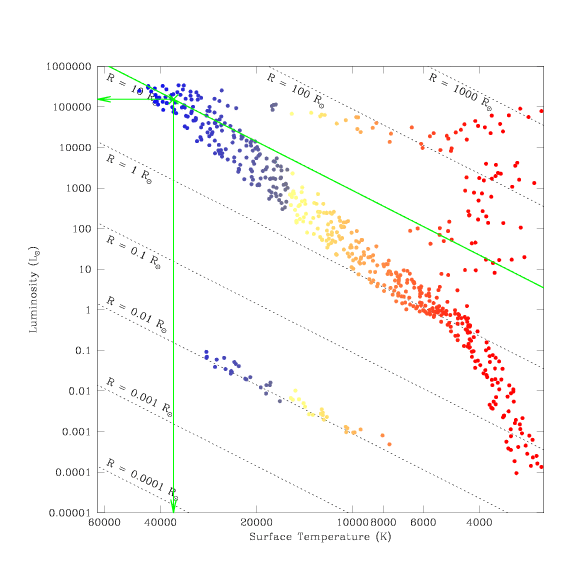What kind of stars are found here?
A star in this region of the Hertzsprung-Russell diagram has a temperature of
roughly 36,000 Kelvin (36,400 K), a luminosity 155,000 times greater than that
of the Sun (155,000 × L ), and a radius roughly ten times larger than
the Sun (R = 10 × R
), and a radius roughly ten times larger than
the Sun (R = 10 × R ).
This star lies along the Main Sequence, where most stars (including the Sun)
are found. The high temperature indicates very blue (hot) colours. Located
at the high end of the Main Sequence, this star is one of the brightest in the
galaxy.
).
This star lies along the Main Sequence, where most stars (including the Sun)
are found. The high temperature indicates very blue (hot) colours. Located
at the high end of the Main Sequence, this star is one of the brightest in the
galaxy.
Try to read the values of L, T, and R for yourself from the diagram. Do
you estimate values for the luminosity, temperature, and size of the star
similar to those listed above?

How can we find the exact luminosity L of a star in this region of
the Hertzsprung-Russell diagram, if we know its temperature T and its radius
R?
We can use the Stephan-Boltzmann Law to relate the temperature (T), size (R),
and luminosity (L) of a star to each other. Measuring L, R, and T in solar
units, we say that:

Let us say that the temperature of the star is exactly 36,400 K. We know that
the temperature of the Sun is 5,800 K, so we can convert the temperature of
the star into solar units. This is just a way of asking How hot is the
star relative to the Sun? (If the star is twice as hot as the Sun, for
example, T = 2 × T . If the star is half as hot as the Sun, T = 0.5
× T
. If the star is half as hot as the Sun, T = 0.5
× T .)
.)

This star is roughly six times hotter than the Sun.
Now assume that the radius of the star is exactly 9.96 × R . (We don't
need to convert this radius to solar units, as we are already using them.)
The final step is to calculate the luminosity L, from T and R.
. (We don't
need to convert this radius to solar units, as we are already using them.)
The final step is to calculate the luminosity L, from T and R.

We estimated a similar value of L = 155,000 L from the
diagram – so we did a good job working with our eyes!
from the
diagram – so we did a good job working with our eyes!
 ), and a radius roughly ten times larger than
the Sun (R = 10 × R
), and a radius roughly ten times larger than
the Sun (R = 10 × R ).
This star lies along the Main Sequence, where most stars (including the Sun)
are found. The high temperature indicates very blue (hot) colours. Located
at the high end of the Main Sequence, this star is one of the brightest in the
galaxy.
).
This star lies along the Main Sequence, where most stars (including the Sun)
are found. The high temperature indicates very blue (hot) colours. Located
at the high end of the Main Sequence, this star is one of the brightest in the
galaxy.



